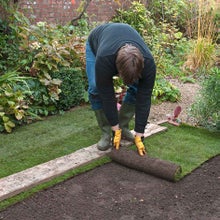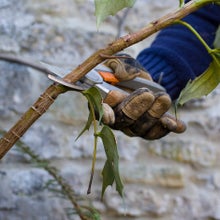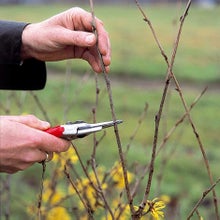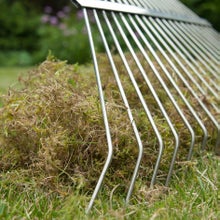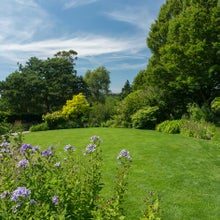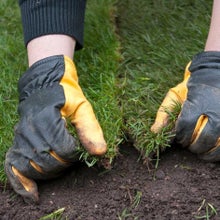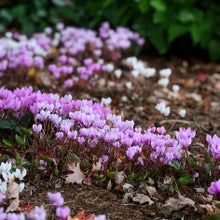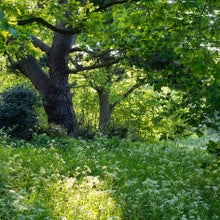
Quick facts
Suitable for - Lawns in moderate shade
Timing - Mainly spring and autumn
Difficulty - Moderate
Suitable for...
All lawns in shade need additional care. Most species of turf grass require four to six hours of full sun each day to grow well. Without this, grass tends to deteriorate because it doesn’t get enough light to sustain itself.
Lawns under trees with dense canopies, such as oak, beech or conifers, rarely do well, as they can lose up to 95 per cent of the sunlight in summer. In addition, the tree roots out-compete the grass for water and nutrients.
Creating a new lawn in shade
It's important to choose a shade-tolerant grass mix – these are now widely available as both seed and turf. They contain a high proportion of fescue grasses, which are better at coping with shade, drought and low nutrient levels.
In damp shade, opt for a mix with more bent grasses (species of Agrostis).
Under trees, sow lawn seed while the tree is leafless if possible – in late autumn or early spring – so the young grass benefits from good light levels while it gets established.
Bear in mind that even shade-tolerant grasses need some light, so if your area is in deep shade you will probably never achieve a fine-quality lawn and instead may be better choosing other shade-loving plants.
For full details on how to sow a new lawn or lay turf, see our guides:
Looking after lawns in shade
Reducing the shade
If the shade is cast by trees or shrubs, consider out selected branches to increase the amount of light reaching the lawn. This may involve crown lifting, where the lower trunk is cleared of branches, or crown thinning, where the entire canopy is thinned. A tree surgeon can advise on the best method.
See our guide to hiring contractors for advice on finding a tree surgeon.
Also see:
It is actually beneficial to have a turf-free zone of at least 1m (3¼ft) around the base of trees, especially young ones, to avoid grass competing with the tree for moisture, and vice versa. You can cover the ground with mulch to keep it weed free.
When planting a new tree in or near a lawn, consider choosing a tree with an open canopy that casts only light shade, such as birch, honey locust and robinia.
Mowing
Mow lawns in shade less frequently, as the grass will grow less quickly. Also, raise the cutting height to at least 6cm (2½in) or even up to 9cm (3½in). Always remove the clippings.
Watering
Even when not in full sun, lawns can still get very dry in hot summers and the grass may turn brown. This isn’t usually anything to worry about, as most lawns recover once rain returns, so watering grass is not generally recommended. See our advice on caring for lawns during drought.
However, the problem can be even worse under trees, especially if the grass is not very robust to start with. It may be shaded from rain and any moisture that does reach the ground may be taken up by the tree roots. In this case, the best option is to water heavily yet infrequently, to encourage the tree to root deeply. This will reduce the extent to which it competes with the lawn. Consider using grey water (such as washing-up water) if possible, rather than mains water.
Feeding
Lawns in shade are best fed in autumn, just before trees lose their leaves. Autumn lawn feeds are rich in potassium (K), which is particularly beneficial to grass in shade.
You can also feed in early spring, about a month before trees come into leaf. Use a specific spring/summer lawn feed and apply at half the rate recommended for turf in full sun.
See our guides to autumn and spring lawn care for details:
Moss in lawns
Moss often thrives in shady, damp areas. With most lawns, a certain amount of moss is not usually a problem and contributes to the lush greenness we like to see. From a distance, a carpet of green moss looks better than bare soil.
Moss is only a problem if the grass can’t grow well because of it. In that case, the priority is to improve the growing conditions for the grass by letting in more light, as explained above. There are also chemical treatments that can be used to help remove the moss while the grass recovers, however this will only work if the shade has been reduced. See our advice in moss in lawns for more information.
Repairing patchy lawns
Shady areas of lawn often become sparse or develop bare patches, but the reason for this deterioration should be sorted out before repairs are made:
- If trees or shrubs are casting too much shade, cut them back to improve light levels – see our tree pruning guide
- If the soil is compacted and/or gets , then the ground by spiking it – see our guide to autumn lawn care and our advice on waterlogged lawns
- If fertility is low, then apply feed in autumn – see our guide to autumn lawn care
Once the underlying problems are improved, then you can re-seed or re-turf the area with a specific shade-tolerant grass mix. See the following guides for full instructions:
Problem solving
In areas of deep shade – cast by buildings, large trees, evergreen shrubs and hedges, etc – grass will always struggle, even shade-tolerant species. So consider growing other plants that will thrive in those conditions – see the following guides for ideas:

